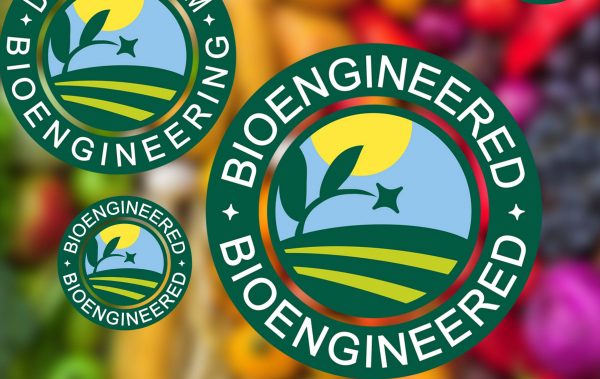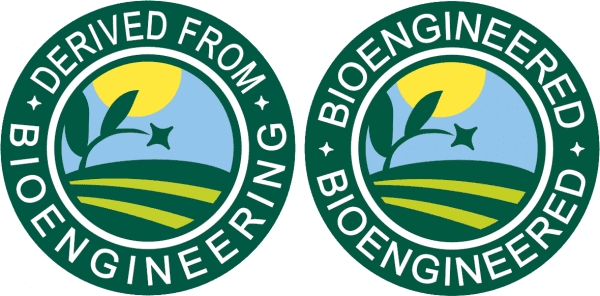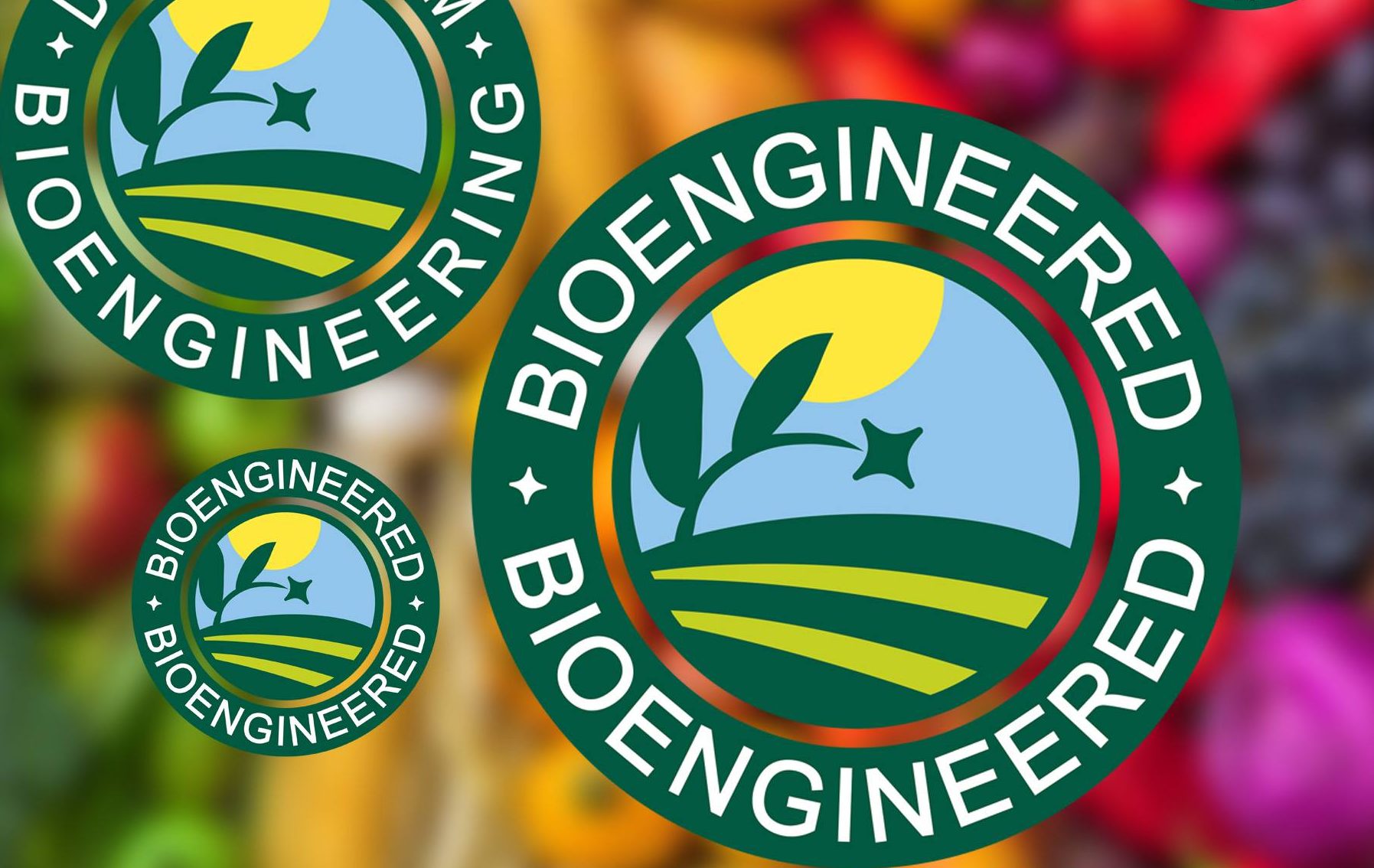Fruits & Vegetables

National Bioengineered Food Disclosure Standard – Released: December 20, 2018
Introduction

Figure 1. New Bioengineered food label with produce in background..
Composite made using iStock image by Bojsha65
In 2016 the United States Congress passed an amendment to the Agricultural Marketing Act of 1946. This amendment asked the U.S. Secretary of Agriculture to develop regulations to establish a national mandatory bioengineered food disclosure standard, providing a uniform national standard for labeling bioengineered foods. This new standard was developed in the hope to provide clarity and transparency within our food system and provide consumers information on the bioengineered status of their foods.
The United States Department of Agriculture – Agricultural Marketing Service (USDA-AMS, www. ams.usda.gov) announced the National Bioengineered Food Disclosure Standard (NBFD Standard: www.ams. usda.gov/rules-rebulations) on December 20, 2018. The implementation date of the Standard is January 1, 2020 (small food manufacturer, January 1, 2021). The mandatory compliance date is January 1, 2022.
This document will provide a summary and highlights of the NBFD Standard for consumers. With the development and implementation of the new NBFD Standard, the USDA and other federal regulatory agencies wanted to emphasize that the new disclosure Standard is a marketing label and does not imply or define the health, safety or environmental attributes of bioengineered food:
“Nothing in this disclosure requirements set out in this final rule conveys information about the health, safety, or environmental attributes of BE food as compared to non-BE counterparts. In fact, the regulatory oversight by USDA and other Federal Government agencies ensures that food produced through bioengineering meets all relevant Federal health, safety, and environmental standards.” (Federal Register 2018, vol. 83, No. 245, p65814-65876)
What is defined as bioengineered with respect to food under the NBFD Standard?
There have been some confusion with the interchangeable use of the terms “Genetically Modified Organism”, “GMO”, “Bioengineered”, and “Genetic Engineering”. This has added to the consumer confusion and anxiety.
Therefore, disclosures under the new Standard will only use the term “Bioengineered”. The term “Bioengineered” or “Derived from Bioengineering” foods are defined as food:
- “(A) that contains genetic material that has been modified through in vitro recombinant deoxyribonucleic acid (rDNA) techniques; and
- (B) for which the modification could not otherwise be obtained through conventional breeding or found in nature.”
Only foods that meet the NBFD Standard’s definition of bioengineered food will be required to have the disclosure label.
Food that is improved or enhanced does not necessarily make it bioengineered. The technology used, in this case bioengineering, to develop the food is covered by the NBFD Standard. All other crop/food improvement technologies are not covered. (For more information about the use of bioengineering in food development: https://www.aces.edu/blog/topics/fruits-vegetablesurban/gmo-food-facts-bioengineered-crops/)
What foods will be labeled under the NBFD Standard?
The disclosure standard label will only apply to human food that is subject to Federal Food, Drug, and Cosmetic Act (FD&C Act www.fda.gov/regulatory-information/search-fda-guidance-documents/guidance-industry-food-labeling-guide) and USDA Food Safety and Inspection Service (FSIS www.fsis.usda.gov/wps/portal/fsis/home) labeling requirements.
The disclosure standard will not apply to foods that are primarily comprised of meat: pork, beef, sheep, goat, catfish, chicken, turkey, domesticated birds or egg products. Products of this nature are covered under the Federal Meat Inspection Act (FMIA), Poultry Product Inspection Act (PPIA) and Egg Product Inspection Act (EPIA) and are not subject to the NBFD Standard. To determine if the primary ingredient is a meat or egg product, look at the first ingredient on the ingredient list of the food product.
Food that have refined ingredients that are bioengineered or derived from bioengineering and do not have any detectable rDNA material are exempt from the disclosure labeling. Highly processed foods that do not contain detectable levels of rDNA are not be subject to disclosure labeling (i.e. refined sugars and oils from bioengineered sugar beets, soybeans, and canola). Meat from livestock fed bioengineered feed, spirits or beer distilled or brewed from bioengineered grains or potatoes are not subject to disclosure labeling. Also exempt from disclosure labeling are USDA adopted incidental additives (foods or ingredients used in insignificant amounts and have no technical or functional effect, Title 21 CFR 101.100 (a)(3) https://www.govinfo.gov/content/pkg/CFR-2018-title21-vol2/xml/CFR-2018-title21-vol2-sec101-100.xml). A threshold standard of exemption for disclosure labeling recognizes and allows up to five percent of a bioengineered substance be present in food, provided it was inadvertent or technically unavoidable. A final exemption involve food certified under the National Organic Program (https://www.ams.usda.gov/about-ams/programs-offices/national-organicprogram).
The USDA-AMS keeps an up to date list of all bioengineered foods commercially available within the U.S. and internationally (www.ams.usda.gov/rules-regulations/be/bioengineered-foods-list). This list is annually reviewed and necessary updates are made through the federal rulemaking process.

Figure 2 and 3. Official NBFD Standard symbols. Official USDA-AMS
Bioengineered and Derived from Bioengineering.
How are bioengineered foods to be labeled and what do the labels look like?
Disclosure of a bioengineered food will be accomplished by the following methods: 1. Text, (a) “Bioengineered Food”, for a raw agricultural commodity or processed food that contains only bioengineered ingredients, and (b) “Contains bioengineered food ingredient” for multi-ingredient food that contain one or more bioengineered food ingredients, 2. Official NBFD Standard symbols (see below Fig 1 & 2 Official USDA-AMS Bioengineered and Derived from Bioengineering), 3. Electronic or digital link (such as a QR Code) accompanied by the statement “Scan here for more food information” and a contact number where the consumer can obtain the information, 4. Text message: the label must include the statement “Text [command word] to [number] for bioengineered food information.”
The NBFD Standard disclosure must appear on either the front panel; near the distributor name and address on the information panel, or on an alternate panel likely to be seen by the consumer under normal shopping conditions.
Who will be required to provide BE disclosure labeling under the NBFD Standard?
Regulated entities, under the NBFD Standard, required to provide BE disclosure labeling include: food manufacturers, importers and certain retailers. Retailers who package food or sell food in bulk are responsible for ensuring that the BE food bears the BE disclosure label. Small food manufacturers that manufacture less than $2.5 Million in annual receipts are exempt from the NBFD Standard.
The NBFD Standard exempts food served in restaurants or similar retail food establishments (“…cafeteria, lunch room, food stand, food truck, transportation carrier… saloon, tavern, bar, lounge, or other similar establishment operated as an enterprise engaged in the business of selling prepared food to the public, or salad bars, delicatessens, and other food enterprises located within retail establishments that provide ready-to-eat foods that are consumed either on or outside the retailer’s premises.” www.ams.usda.gov/rules-regulations/be/regulated-entities) provide ready-to-eat foods that are consumed either on or outside the retailer’s premises.” www.ams.usda.gov/rules-regulations/be/regulated-entities).
Additional Information
Additional information about the NBFD Standard can be found on the USDA-AMS website www.ams.usda.gov/rules-rebulations.
These sites also contain information regarding the BE labeling law:
- USDA Agricultural Marketing Service
www.ams.usda.gov - EPA Biotechnology Use in Pest Management Regulations
www.epa.gov/regulation-biotechnology-under-tsca-and-fifra/epas-regulation-biotechnology-use-pest-management - FDA Food Genetically Engineered Plants Regulations
www.fda.gov/food/food-new-plant-varieties/how-fda-regulates-food-genetically-engineered-plants - FDA Genetically Engineered Plants Consumer Information
www.fda.gov/food/food-new-plant-varieties/consumer-info-about-food-genetically-engineered-plants - NAS Genetically Engineered Crops Review
nas-sites.org/ge-crops/


